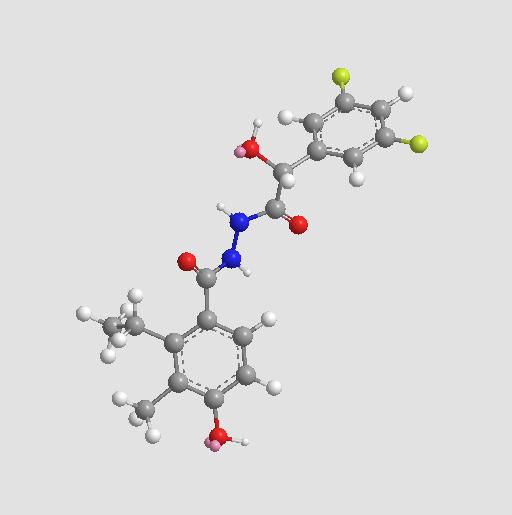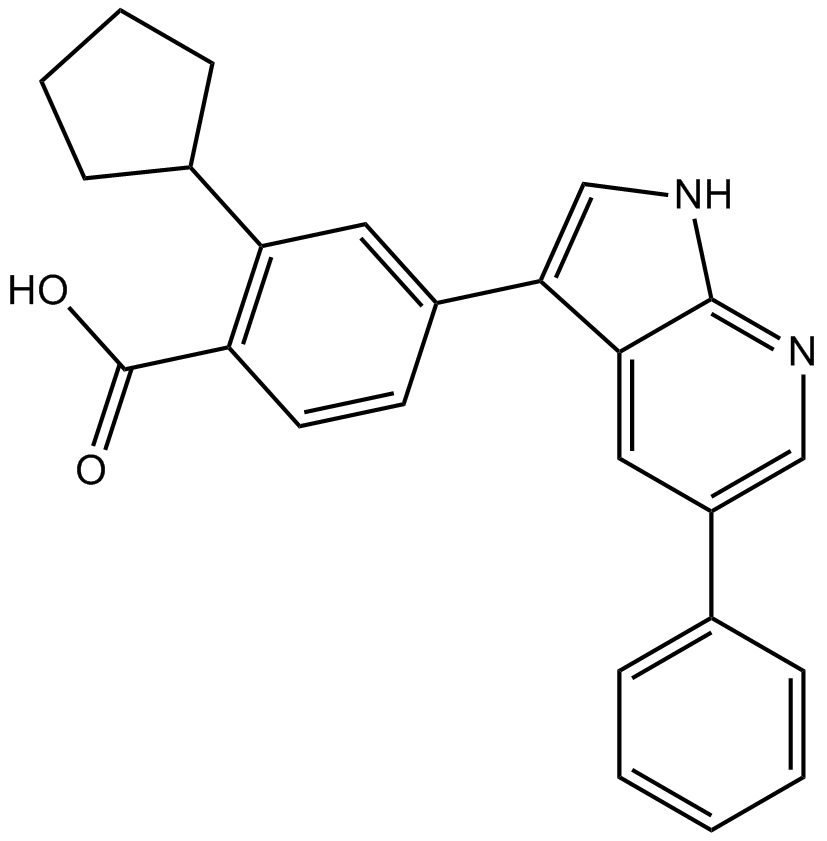EMD638683
EMD638683 is a highly selective inhibitor of the serum and glucocorticoid inducible kinase (SGK) with IC50 value of 3 μM [1].
SGK is a group of serine/threonine kinases that consists of SGK1, SGK2 and SGK3. Among these, SGK1 takes participate in the signaling pathway that regulates the sodium channel, cell proliferation, cell survival and many other cellular processes. The transcription of SGK1 can be up-regulated by the activation of serum, mineralocorticoids and glucocorticoids. SGK1 enhanced the renal tubular reabsorption of sodium after the high salt activation. Besides that, SGK is highly expressed in some sorts of tumors while down-regulated in some other tumors such as APC. The selective SGK1 inhibitor EMD638683 showed inhibition effects on all the three forms of SGK but not for other kinases. It can affect the phosphorylation of NDRG1in vitro and meanwhile exert anti-tumor or anti-hypertensive efficacy in vivo [1, 2].
In the biochemical kinase assays, EMD638683 at concentration of 1 μM inhibited 85%, 71% and 75% activities of SGK1, SGK2 and SGK3, respectively. It also had inhibitory effects on MSK1 (mitogen-and stress-activated protein kinase 1) and PRK2 (protein kinase C-related kinase 2) with IC50 values of ≤ 1 μM. For other 64 kinases, such as MAPK, PRAK and Syk, EMD638683 showed no significant inhibition. In HeLa cells, EMD638683 suppressed the phosphorylation of NDRG1, which is a target of SGK1, with IC50 value of 3.35 μM. Besides that, EMD638683 treated CaCo-2 cells displayed increased depolarized mitochondria and enhanced caspase activity after the exposure to radiation [1, 2].
In mice treated with the carcinogenic drugs, the administration of EMD638683 at dose of 600 mg/kg/day significantly lowered the colon weight and reduced the developing tumors. In another mice experiment, administration of EMD638683 increased the urinary output and normalized the systolic blood pressure in mice treated with 10% fructose drinking water. It indicated that EMD638683 might be an attracted drug for the hypertension treatment in diabetic patients [1, 2].
References:
[1] Towhid S T, Liu G L, Ackermann T F, et al. Inhibition of colonic tumor growth by the selective SGK inhibitor EMD638683. Cellular physiology and biochemistry: international journal of experimental cellular physiology, biochemistry, and pharmacology, 2012, 32(4): 838-848.
[2] Ackermann T F, Boini K M, Beier N, et al. EMD638683, a novel SGK inhibitor with antihypertensive potency. Cellular Physiology and Biochemistry, 2011, 28(1): 137-146.
- 1. Michael A Hill, Yan Yang, et al. "Endothelial Cell Serum and Glucocorticoid Regulated Kinase 1 (SGK1) Mediates Vascular Stiffening." Metabolism. 2021 Jun:119:154766. PMID: 33766485
- 2. Shenglan Wang, Simin Qi, et al. "The ubiquitin E3 ligase Nedd4‐2 relieves mechanical allodynia through ubiquitination of TRPA1 channel in db/db mice." Eur J Neurosci. 2020 Nov 25. PMID:33236491
- 3. Greenawalt EJ, Edmonds MD, et al. "Targeting of SGK1 by miR-576-3p Inhibits Lung Adenocarcinoma Migration and Invasion." Mol Cancer Res. 2018 Sep 26. PMID:30257988
- 4. Schmid E, Stagno MJ, et al. "Serum and Glucocorticoid Inducible Kinase 1-Sensitive Survival,Proliferation and Migration of Rhabdomyosarcoma Cells." Cell Physiol Biochem. 2017 Oct 9;43(3):1301-1308. PMID:28992614
- 5. Mason JA, Davison-Versagli CA, et al. "Oncogenic Ras differentially regulates metabolism and anoikis in extracellular matrix-detached cells." Cell Death Differ. 2016 Feb 26. PMID:26915296
- 6. Dr.Alvaro Diaz. "Condicionamiento de células dendríticas por la capa laminar de Echinococcus granulosus: búsqueda de agonistas y mecanismos a nivel de se?alizacón." colibri.udelar.edu.uy.2016.
| Physical Appearance | A solid |
| Storage | Store at -20°C |
| M.Wt | 364.34 |
| Cas No. | 1181770-72-8 |
| Formula | C18H18F2N2O4 |
| Synonyms | EMD 638683;EMD-638683 |
| Solubility | insoluble in H2O; ≥18.2 mg/mL in DMSO; ≥45.8 mg/mL in EtOH with gentle warming |
| Chemical Name | N'-[2-(3,5-difluorophenyl)-2-hydroxyacetyl]-2-ethyl-4-hydroxy-3-methylbenzohydrazide |
| SDF | Download SDF |
| Canonical SMILES | CCc(c(C)c(cc1)O)c1C(NNC(C(c1cc(F)cc(F)c1)O)=O)=O |
| Shipping Condition | Small Molecules with Blue Ice, Modified Nucleotides with Dry Ice. |
| General tips | We do not recommend long-term storage for the solution, please use it up soon. |
| Cell experiment: [1] | |
|
Cell lines |
HeLa-cells |
|
Preparation method |
The solubility of this compound in DMSO is >10 mM. General tips for obtaining a higher concentration: Please warm the tube at 37 °C for 10 minutes and/or shake it in the ultrasonic bath for a while.Stock solution can be stored below -20°C for several months. |
|
Reaction Conditions |
10 μM , 24 hours |
|
Applications |
As an inhibitor of SGK1, EMD638683 inhibited the phosphorylation of NDRG1 (N-Myc downstream-regulated gene 1), a specific target of SGK1. The IC50 value is 3.35 μM. |
| Animal experiment : [1] | |
|
Animal models |
SGK1 deficient mice ((sgk1-/-) |
|
Dosage form |
In chow, 600mg/kg, 4 days |
|
Applications |
The tap drinking water was replaced by 10 % fructose for 3 weeks to develop hyperinsulinemia. Treatment of EMD638683 for four days led to normalization of systolic blood pressure (from 111 ± 4 to 87 ± 3 mmHg). It did not significantly modify fluid and food intake and did not significantly alter the urinary Na+ and K+ excretion, but significantly increased the urinary output and significantly decreased body weight. |
|
Other notes |
Please test the solubility of all compounds indoor, and the actual solubility may slightly differ with the theoretical value. This is caused by an experimental system error and it is normal. |
|
References: [1] Ackermann T F, Boini K M, Beier N, et al. EMD638683, a novel SGK inhibitor with antihypertensive potency. Cellular Physiology and Biochemistry, 2011, 28(1): 137-146. |
|
| Description | EMD638683 is a potent inhibitor of SGK1 with an IC50 value of 3 μM. | |||||
| Targets | SGK1 | |||||
| IC50 | 3 μM | |||||
Quality Control & MSDS
- View current batch:
Chemical structure
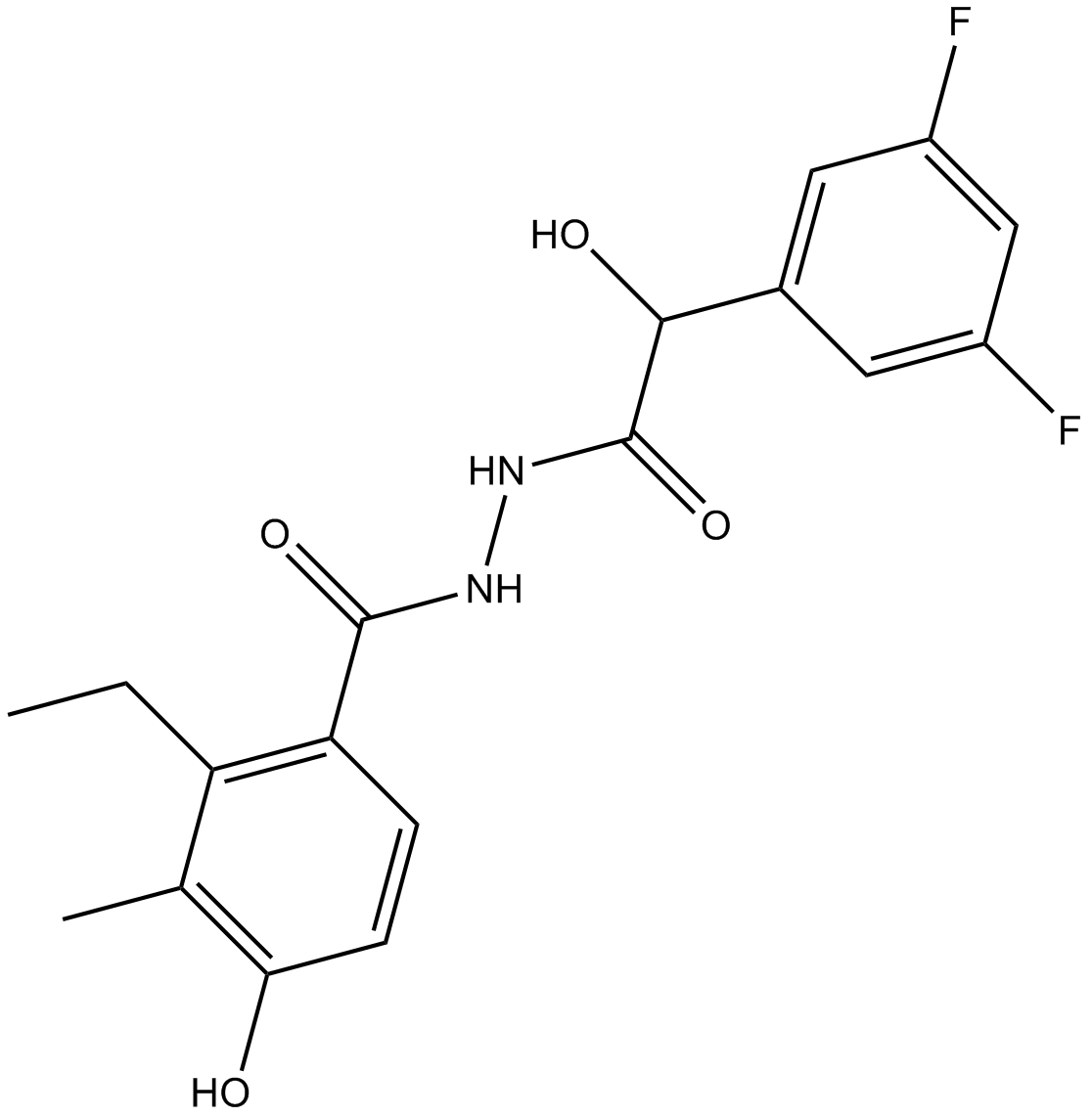
Related Biological Data
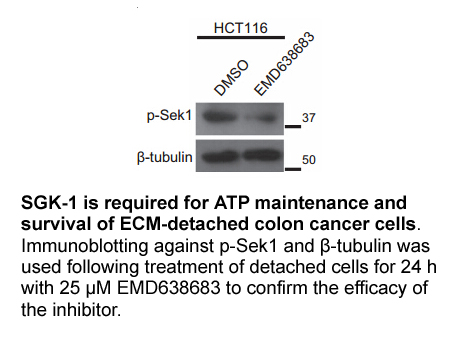
Related Biological Data
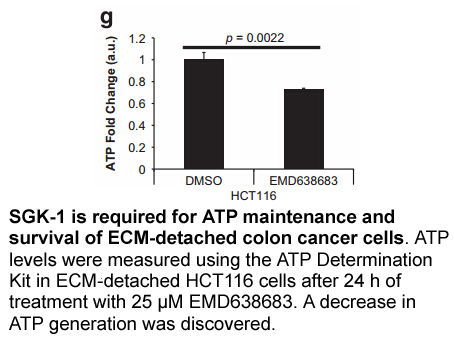
Related Biological Data
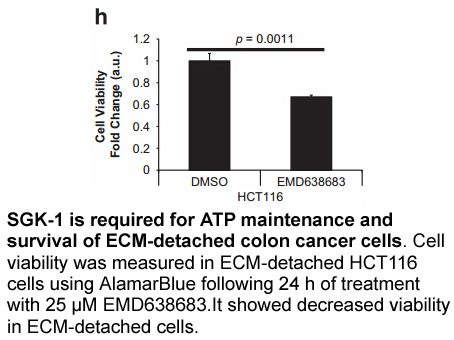
Related Biological Data
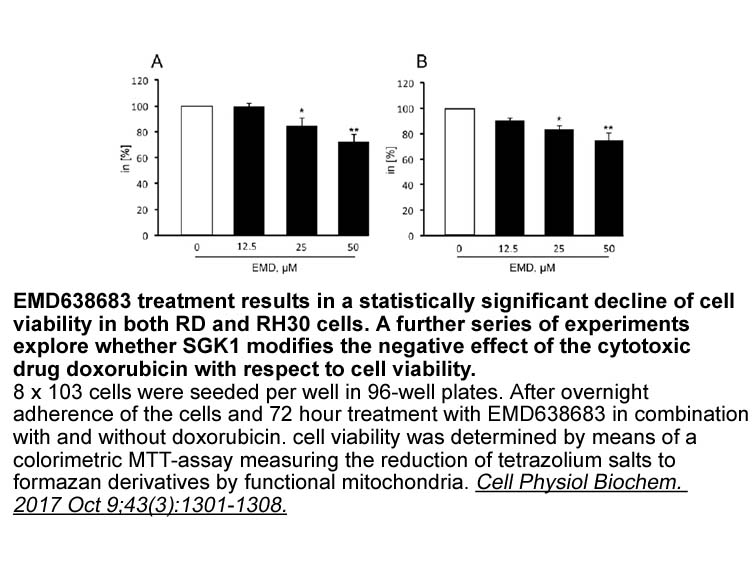
Related Biological Data
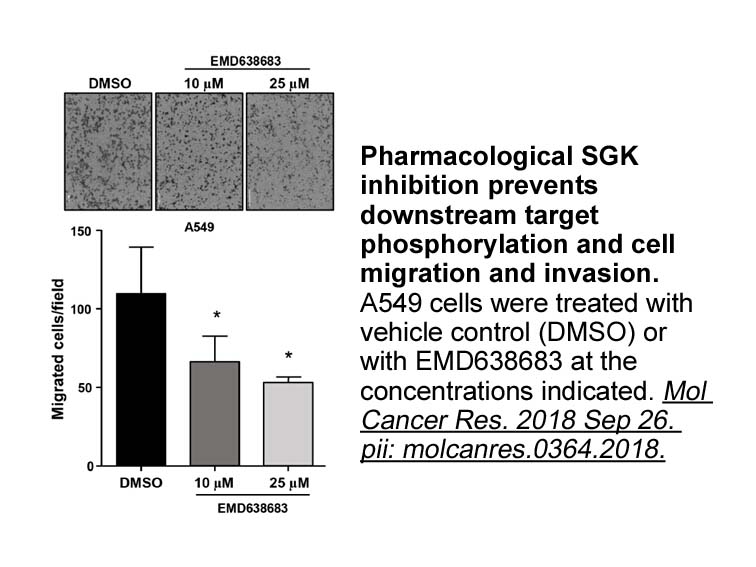
Related Biological Data




